Neel Kanth Kundu
Analog Quantum Image Representation with Qubit-Frugal Encoding
Dec 20, 2025Abstract:In this work, we introduce a fundamentally new paradigm for quantum image representation tailored for neutral-atom quantum devices. The proposed method constructs a qubit-efficient image representation by first applying a cartographic generalization algorithm to a classical edge-extracted input image, yielding a highly optimized sparse-dot based geometric description. While ensuring the structural integrity of the image, this sparse representation is then embedded into the atomic configuration of Aquila (QuEra Computing Inc.), modeled through the Bloqade simulation software stack. By encoding visual information through physical atom placement rather than digital basis-state coding, the approach avoids the costly state-preparation overhead inherent to digital quantum image processing circuits. Additionally, pruning sparse dot images, akin to map feature reduction, compresses representations without fidelity loss, thereby substantially reducing qubit requirements when implemented on an analog neutral-atom quantum device. The resulting quantum-native images have been successfully evaluated through matching tasks against an image database, thus illustrating the feasibility of this approach for image matching applications. Since sparse-dot image representations enable seamless generation of synthetic datasets, this work constitutes an initial step towards fully quantum-native machine-learning pipelines for visual data and highlights the potential of scalable analog quantum computing to enable resource-efficient alternatives to energy-intensive classical AI-based image processing frameworks.
Rydberg Atomic RF Sensor-based Quantum Radar
Dec 19, 2025Abstract:Rydberg atom-based RF sensors offer distinct advantages over conventional dipole antennas for electric field detection. This paper presents a system model and performance analysis of a Rydberg atom-based quantum radar, which employs optical readout via lasers and photon detectors instead of circuit-based receivers. We derive the signal-to-noise ratio (SNR), compare it with classical radar, and estimate Doppler frequency using an invariant function-based method. Simulations show that the quantum radar achieves higher SNR and lower RMSE in velocity estimation than conventional radar.
A Qubit-Efficient Hybrid Quantum Encoding Mechanism for Quantum Machine Learning
Jun 24, 2025Abstract:Efficiently embedding high-dimensional datasets onto noisy and low-qubit quantum systems is a significant barrier to practical Quantum Machine Learning (QML). Approaches such as quantum autoencoders can be constrained by current hardware capabilities and may exhibit vulnerabilities to reconstruction attacks due to their invertibility. We propose Quantum Principal Geodesic Analysis (qPGA), a novel, non-invertible method for dimensionality reduction and qubit-efficient encoding. Executed classically, qPGA leverages Riemannian geometry to project data onto the unit Hilbert sphere, generating outputs inherently suitable for quantum amplitude encoding. This technique preserves the neighborhood structure of high-dimensional datasets within a compact latent space, significantly reducing qubit requirements for amplitude encoding. We derive theoretical bounds quantifying qubit requirements for effective encoding onto noisy systems. Empirical results on MNIST, Fashion-MNIST, and CIFAR-10 show that qPGA preserves local structure more effectively than both quantum and hybrid autoencoders. Additionally, we demonstrate that qPGA enhances resistance to reconstruction attacks due to its non-invertible nature. In downstream QML classification tasks, qPGA can achieve over 99% accuracy and F1-score on MNIST and Fashion-MNIST, outperforming quantum-dependent baselines. Initial tests on real hardware and noisy simulators confirm its potential for noise-resilient performance, offering a scalable solution for advancing QML applications.
Quantum code division multiple access based continuous-variable quantum key distribution
Feb 13, 2025Abstract:In this paper, we propose a quantum code division multiple access (q-CDMA) based continuous-variable quantum key distribution (CV-QKD) system. In the proposed system, the quantum states of two senders ($\text{Alice}_{1,2}$) are chaotically encoded through chaotic phase shifters and then transmitted over a quantum channel. At the receiver, the quantum states are decoded via chaos synchronization to separate the quantum states sent by the different senders and received by the two receivers ($\text{Bob}_{1,2}$) separately. We characterize the input-output relation of the quadrature between the two senders and receivers and then analyze the secret key rate (SKR) of the q-CDMA-based CV-QKD system. Our numerical results reveal that the q-CDMA approach can significantly enhance the SKR for both users when compared to the single-user case without the q-CDMA approach.
Hybrid Quantum Neural Network based Indoor User Localization using Cloud Quantum Computing
Oct 01, 2024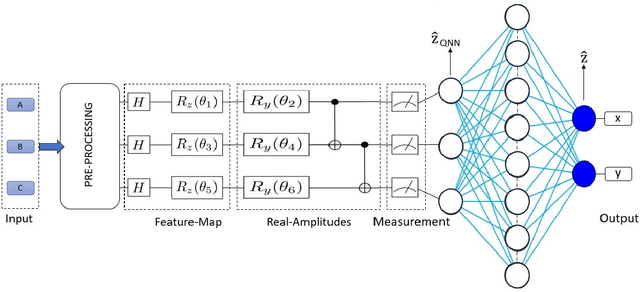
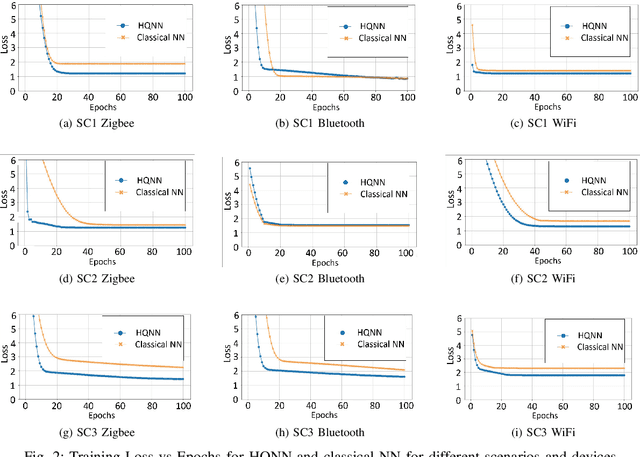


Abstract:This paper proposes a hybrid quantum neural network (HQNN) for indoor user localization using received signal strength indicator (RSSI) values. We use publicly available RSSI datasets for indoor localization using WiFi, Bluetooth, and Zigbee to test the performance of the proposed HQNN. We also compare the performance of the HQNN with the recently proposed quantum fingerprinting-based user localization method. Our results show that the proposed HQNN performs better than the quantum fingerprinting algorithm since the HQNN has trainable parameters in the quantum circuits, whereas the quantum fingerprinting algorithm uses a fixed quantum circuit to calculate the similarity between the test data point and the fingerprint dataset. Unlike prior works, we also test the performance of the HQNN and quantum fingerprint algorithm on a real IBM quantum computer using cloud quantum computing services. Therefore, this paper examines the performance of the HQNN on noisy intermediate scale (NISQ) quantum devices using real-world RSSI localization datasets. The novelty of our approach lies in the use of simple feature maps and ansatz with fewer neurons, alongside testing on actual quantum hardware using real-world data, demonstrating practical applicability in real-world scenarios.
Optimal Grouping Strategy for Reconfigurable Intelligent Surface Assisted Wireless Communications
Nov 20, 2021
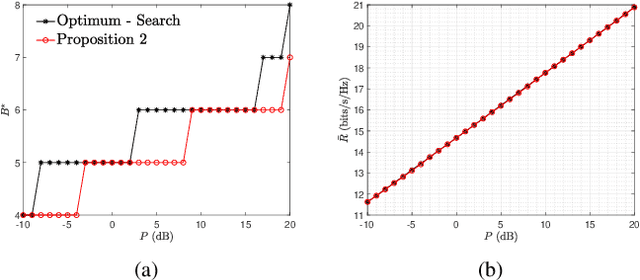

Abstract:The channel estimation overhead of reconfigurable intelligent surface (RIS) assisted communication systems can be prohibitive. Prior works have demonstrated via simulations that grouping neighbouring RIS elements can help to reduce the pilot overhead and improve achievable rate. In this paper, we present an analytical study of RIS element grouping. We derive a tight closed-form upper bound for the achievable rate and then maximize it with respect to the group size. Our analysis reveals that more coarse-grained grouping is important-when the channel coherence time is low (high mobility scenarios) or the transmit power is large. We also demonstrate that optimal grouping can yield significant performance improvements over simple `On-Off' RIS element switching schemes that have been recently considered.
Machine Learning Based Parameter Estimation of Gaussian Quantum States
Aug 13, 2021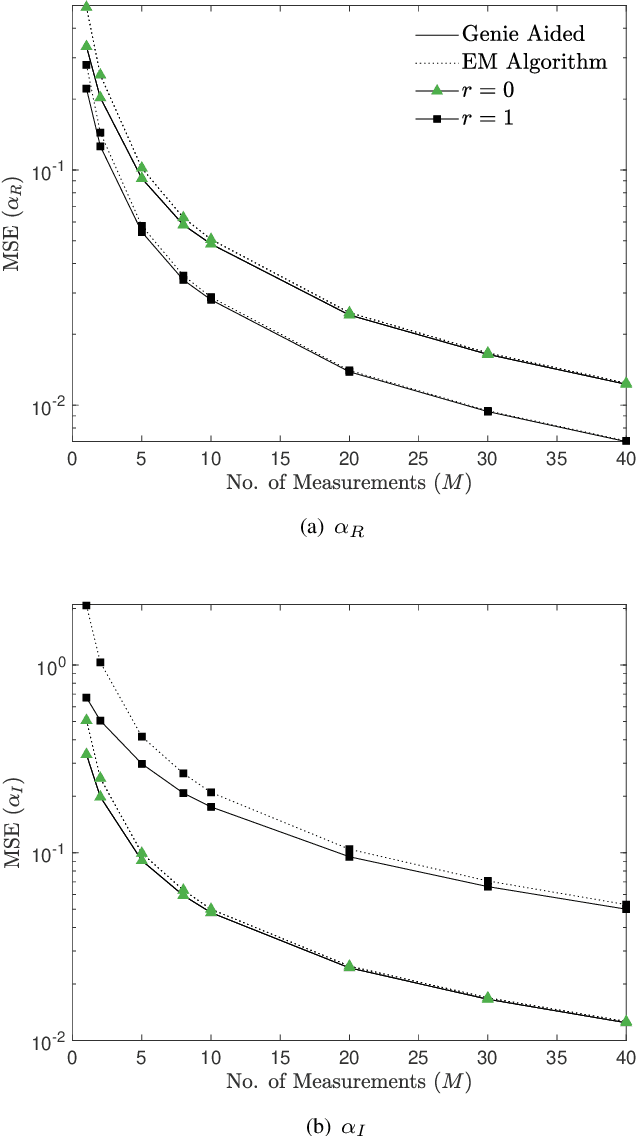
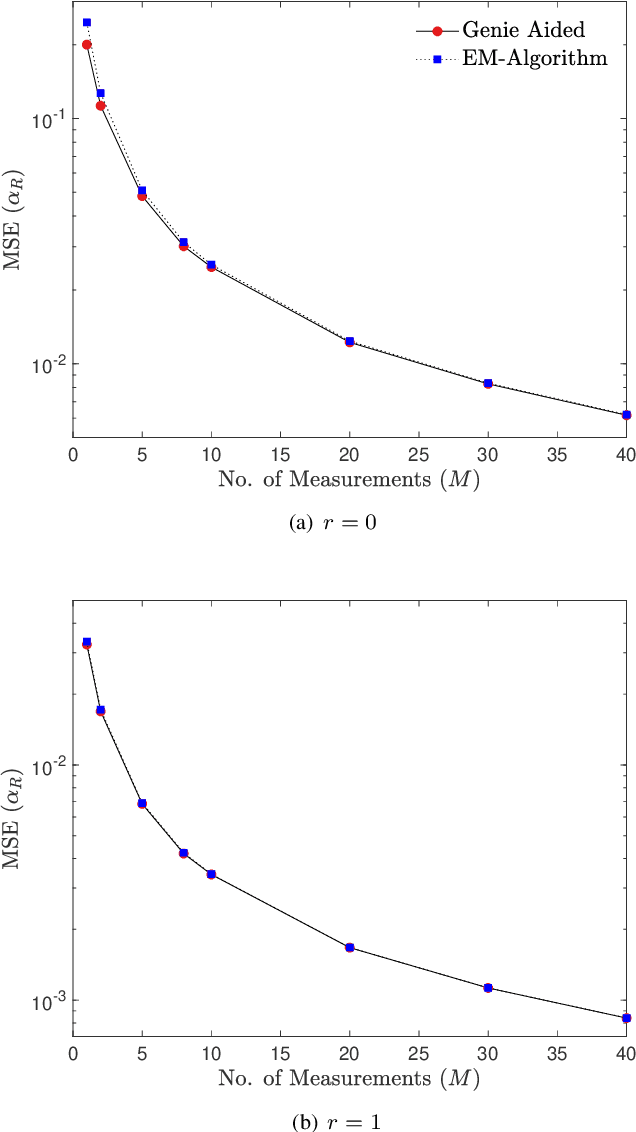
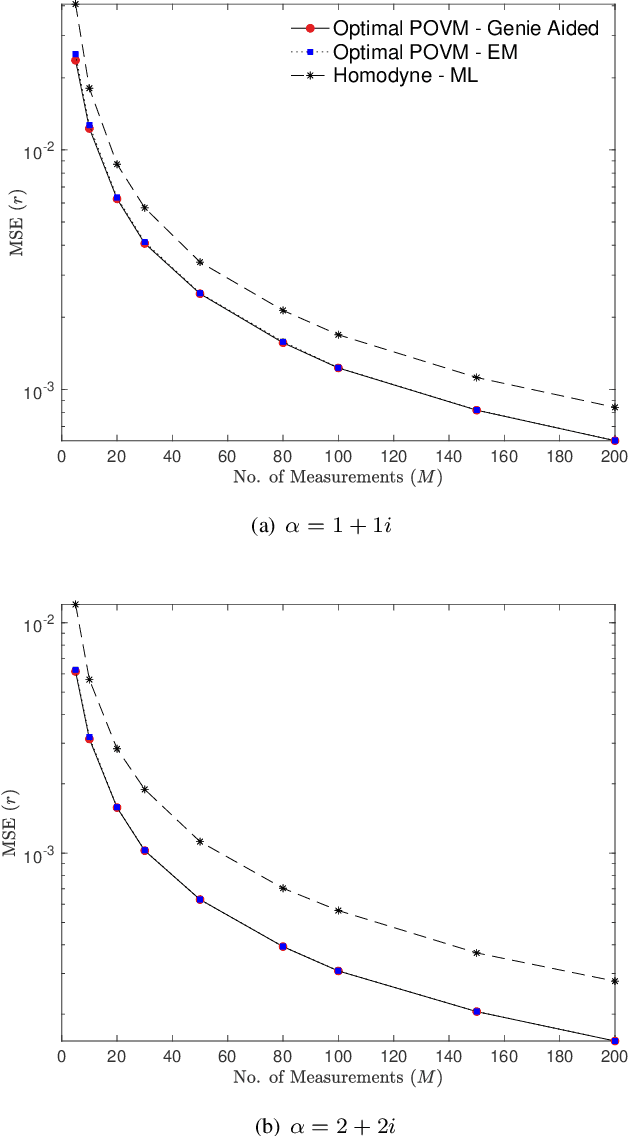

Abstract:We propose a machine learning framework for parameter estimation of single mode Gaussian quantum states. Under a Bayesian framework, our approach estimates parameters of suitable prior distributions from measured data. For phase-space displacement and squeezing parameter estimation, this is achieved by introducing Expectation-Maximization (EM) based algorithms, while for phase parameter estimation an empirical Bayes method is applied. The estimated prior distribution parameters along with the observed data are used for finding the optimal Bayesian estimate of the unknown displacement, squeezing and phase parameters. Our simulation results show that the proposed algorithms have estimation performance that is very close to that of Genie Aided Bayesian estimators, that assume perfect knowledge of the prior parameters. Our proposed methods can be utilized by experimentalists to find the optimum Bayesian estimate of parameters of Gaussian quantum states by using only the observed measurements without requiring any knowledge about the prior distribution parameters.
MIMO Terahertz Quantum Key Distribution
May 19, 2021

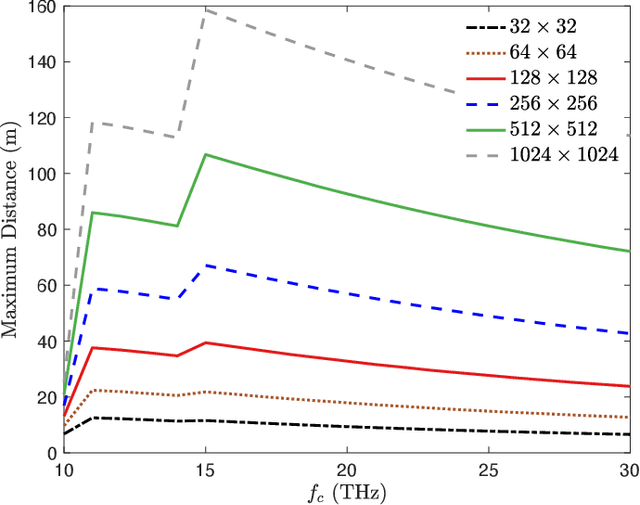
Abstract:We propose a multiple-input multiple-output (MIMO) quantum key distribution (QKD) scheme for improving the secret key rates and increasing the maximum transmission distance for terahertz (THz) frequency range applications operating at room temperature. We propose a transmit beamforming and receive combining scheme that converts the rank-$r$ MIMO channel between Alice and Bob into $r$ parallel lossy quantum channels whose transmittances depend on the non-zero singular values of the MIMO channel. The MIMO transmission scheme provides a multiplexing gain of $r$, along with a beamforming and array gain equal to the product of the number of transmit and receive antennas. This improves the secret key rate and extends the maximum transmission distance. Our simulation results show that multiple antennas are necessary to overcome the high free-space path loss at THz frequencies. Positive key rates are achievable in the $10-30$ THz frequency range that can be used for both indoor and outdoor QKD applications for beyond fifth generation ultra-secure wireless communications systems.
 Add to Chrome
Add to Chrome Add to Firefox
Add to Firefox Add to Edge
Add to Edge